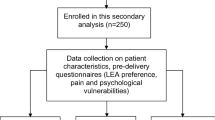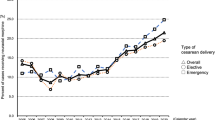Abstract
CONTEXT: Epidural placement for labor in the general population of laboring women is associated with increased incidence of operative deliveries, prolongation of labor, and may be associated with an increased cesarean section rate. The risks and benefits associated with epidural placement for labor in the subpopulation of mothers at high risk for cesarean section have not been studied.
OBJECTIVE: To determine if a population of mothers and babies at high risk for cesarean section will have improved outcomes with labor epidural placement.
DESIGN: A decision and cost analysis examining epidural placement for labor on a population of women who are at high risk for unscheduled cesarean section and may benefit from scheduled cesarean section as determined by threshold analysis was performed. Outcomes and probabilities were determined through analysis of the Department of Defense's 1996 National Quality Management Program (NQMP) Birth Product Line data set containing more than 7000 deliveries. Outcomes were defined using variables comprised of all documented conditions that occurred during the peripartum and neonatal hospitalizations. The 1997 NQMP data set was used to validate the results.
SETTING: Military Treatment Facilities throughout the United States and abroad and civilian facilities in the United States providing care to military dependents.
PATIENT POPULATION: Active duty and dependent pregnant women and babies.
RESULTS: About 8% of mothers in this patient population were found to be at high risk for cesarean section. The decision and cost analyses showed that babies of the high risk mothers who received epidurals for labor had better clinical outcomes ( p<0.05) and the procedure was cost neutral ( p=0.23). The procedure did not increase the frequency of cesarean section, and there was no effect on maternal outcomes scores. These results were confirmed by the validation study.
CONCLUSIONS: There is a sizable subpopulation of women at high risk for cesarean section whose babies may have better outcomes with epidural placement with no sacrifice in maternal outcomes or costs.
This is a preview of subscription content, access via your institution
Access options
Subscribe to this journal
Receive 12 print issues and online access
$259.00 per year
only $21.58 per issue
Buy this article
- Purchase on Springer Link
- Instant access to full article PDF
Prices may be subject to local taxes which are calculated during checkout
Similar content being viewed by others
References
Cohen S Strategies for labor pain relief — past, present and future Acta Anaesthesiol Scand Suppl 1997 110 17–21
Hawthorne L, Wilson R, Lyons G, Dresner M Failed intubation revisited: 17-yr experience in a teaching maternity unit [see comments] Br J Anaesth 1996 76 680–4
Morgan M Anaesthetic contribution to maternal mortality Br J Anaesth 1987 59 842–55
Hueston WJ, McClaflin RR, Mansfield CJ, Rudy M Factors associated with the use of intrapartum epidural analgesia Obstet Gynecol 1994 84 579–82
Thorp JA, Hu DH, Albin RM, et al The effect of intrapartum epidural analgesia on nulliparous labor: a randomized, controlled, prospective trial Am J Obstet Gynecol 1993 169 851–8
Thorp JA, Breedlove G Epidural analgesia in labor: an evaluation of risks and benefits Birth 1996 23 63–83
Lieberman E, Lang JM, Cohen A, D'Agostino R Jr, Datta S, Frigoletto FD Jr Association of epidural analgesia with cesarean delivery in nulliparas Obstet Gynecol 1996 88 993–1000
Rojansky N, Tanos V, Reubinoff B, Shapira S, Weinstein D Effect of epidural analgesia on duration and outcome of induced labor Int J Gynaecol Obstet 1997 56 237–44
Johnson S, Rosenfeld J The effect of epidural aesthesia on the length of Labor J Fam Pract 1995 40 244–247
Gribble RK, Meier PR Effect of epidural analgesia on the primary cesarean rate [see comments] Obstet Gynecol 1991 78 231–4
Chestnut DH Does epidural analgesia during labor affect the incidence of cesarean delivery? Reg Anesth 1997 22 495–9
Chestnut DH, McGrath JM, Vincent RD Jr, et al Does early administration of epidural analgesia affect obstetric outcome in nulliparous women who are in spontaneous labor? [see comments] Anesthesiology 1994 80 1201–8
Halpern S, Leighton B, Ohlsson A, Barrett J, Rice A Effect of epidural vs parenteral opioid analgesia on the progress of labor: a meta-analysis JAMA 1998 280 2105–2110
Sharma S, Sidawi J, Ramin S, et al Cesarean delivery: randomized trial of epidural vs patient-controlled analgesia during labor Anesthesiology 1997 87 487–94
Fogel S, Shyken J, Leighton B, Mormol J, Smeltzer J Epidural labor analgesia and the incidence of cesarean delivery for dystocia Anesth Analg 1998 87 119–23
Thompson T, Thorp J, Mayer D, Kuller J, Bowes W Does epidural analgesia cause dystocia? J Clin Anesth 1998 10 58–65
Clark A, Carr D, Loyd G, Cook V, Spinnato J The influence of epidural analgesia on cesarean delivery rates: a randomized, prospective clinical trial Am J Obstet Gynecol 1998 179 1527–33
Ramin SM, Gambling DR, Lucas MJ, Sharma SK, Sidawi JE, Leveno KJ Randomized trial of epidural versus intravenous analgesia during labor [see comments] Obstet Gynecol 1995 86 783–9
Newton ER, Schroeder BC, Knape KG, Bennett BL Epidural analgesia and uterine function [see comments] Obstet Gynecol 1995 85 749–55
Abboud TK, Afrasiabi A, Sarkis F, et al Continuous infusion epidural analgesia in parturients receiving bupivacaine, chloroprocaine, or lidocaine — maternal, fetal, and neonatal effects Anesth Analg 1984 63 421–8
Alahuhta S, Rasanen J, Jouppila P, et al The effects of epidural ropivacaine and bupivacaine for cesarean section on uteroplacental and fetal circulation Anesthesiology 1995 83 23–32
Bofill JA, Vincent RD, Ross EL, et al Nulliparous active labor, epidural analgesia, and cesarean delivery for dystocia Am J Obstet Gynecol 1997 177 1465–70
Thorp JA, Parisi VM, Boylan PC, Johnston DA The effect of continuous epidural analgesia on cesarean section for dystocia in nulliparous women [see comments] Am J Obstet Gynecol 1989 161 670–5
Macaulay JH, Bond K, Steer PJ Epidural analgesia in labor and fetal hyperthermia [see comments] Obstet Gynecol 1992 80 665–9
Lieberman E, Lang JM, Frigoletto F Jr, Richardson DK, Ringer SA, Cohen A Epidural analgesia, intrapartum fever, and neonatal sepsis evaluation Pediatrics 1997 99 415–9
Krakauer H, Lin MJ, Schone EM, et al “Best clinical practice”: assessment of processes of care and of outcomes in the US Military Health Services System J Eval Clin Pract 1998 4 11–29
Knox AJ, Sadler L, Pattison NS, Mantell CD, Mullins P An obstetric scoring system: its development and application in obstetric management [see comments] Obstet Gynecol 1993 81 195–9
Hueston WJ Development of a cesarean delivery risk score [see comments] Obstet Gynecol 1994 84 965–8
Harlow BL, Frigoletto FD, Cramer DW, et al Epidemiologic predictors of cesarean section in nulliparous patients at low risk. RADIUS Study Group. Routine Antenatal Diagnostic Imaging with Ultrasound Study Am J Obstet Gynecol 1995 172 156–62
Richards RJ Using threshold analysis to improve medical decisions [editorial] Hosp Pract (Off Ed) 1997 32 15–6, 19–21, 25–6
Everett A Piercing the veil of the future. A review of the Delphi method of research Prof Nurse 1993 9 181–5
Detsky AS, Naglie G, Krahn MD, Redelmeier DA, Naimark D Primer on medical decision analysis: Part 2. Building a tree Med Decis Making 1997 17 126–35
Kassirer JP, Moskowitz AJ, Lau J, Pauker SG Decision analysis: a progress report Ann Intern Med 1987 106 275–91
Hsiao WC, Braun P, Dunn DL, et al An overview of the development and refinement of the Resource-Based Relative Value Scale. The foundation for reform of U.S. physician payment Med Care 1992 30 NS1–12
Henry M Jackson Foundation, Version.38 1401 Rockville Pike, Rockville, MD 20852 1995
ACOG Technical Bulletin Obstetric analgesia and anesthesia. Number 225 Int J Gynaecol Obstet 1996 54 281–92
National Natality Survey Public Use Datafile US Department of Health and Human Services, Public Health Service, Centers for Disease Control and Prevention, National Center for Health Statistics, Hyattsville, MD, 1993
Stata Reference Manual, Version 5.0 College Station, TX.: Stata Corporation 1996
Eakes M Economic considerations for epidural anesthesia in childbirth Nurs Econ 1990 8 329–32
Meyer GS, Krakauer H Validity of the department of defense standard inpatient data record for quality management and health Mil Med 1998 163 461–465
Jackson JL, Cheng EY, Jones DL, Meyer GS Comparison of discharge diagnoses and inpatient procedures between Military and Civilian health care systems Mil Med 1999 Oct 164 (10) 701–4
Jackson JL, Strong J, Cheng E, Meyer GS Patients, diagnoses, and procedures in a military internal medicine clinic: comparison with civilian practices Mil Med 1999 164 194–7
Jackson JL, O'Malley PG, Kroenke K A Psychometric comparison of military and civilian medical practices Mil Med 1999 164 112–5
Johnson JE, Pinholt EM, Jenkins TR, Carpenter JL Content of Internal Medicine Practice in an academic Army Medical Center and an Army Community Hospital Mil Med 1988 153 21–25
Acknowledgements
Dr. G. Meyer's work is funded by a Generalist Physician Faculty Scholar Award from the Robert Wood Johnson Foundation.
The authors acknowledge the anonymous reviewers of an earlier version of this manuscript for their thoughtful critique.
Author information
Authors and Affiliations
Additional information
Disclaimer: The opinions and assertions contained herein are the private views of the authors and are not to be construed as official or as reflecting the views of the Department of the Army, Department of the Air Force, the Department of Defense, or the Department of Health and Human Services.
Rights and permissions
About this article
Cite this article
Stuart, K., Krakauer, H., Schone, E. et al. Labor Epidurals Improve Outcomes for Babies of Mothers at High Risk for Unscheduled Cesarean Section. J Perinatol 21, 178–185 (2001). https://doi.org/10.1038/sj.jp.7200519
Published:
Issue Date:
DOI: https://doi.org/10.1038/sj.jp.7200519
This article is cited by
-
Effects on the fetus and newborn of maternal analgesia and anesthesia: a review
Canadian Journal of Anesthesia/Journal canadien d'anesthésie (2004)



